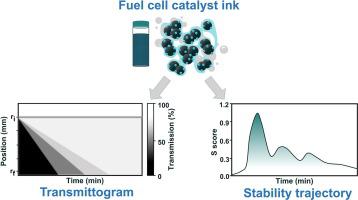Advanced Powder Technology ( IF 4.2 ) Pub Date : 2021-09-06 , DOI: 10.1016/j.apt.2021.08.030 Shalmali Bapat 1 , Christopher Giehl 2 , Sebastian Kohsakowski 3, 4 , Volker Peinecke 3 , Michael Schäffler 2 , Doris Segets 1, 5

|
Catalyst layers (CL), as an active component of the catalyst coated membrane (CCM), form the heart of the polymer electrolyte membrane fuel cell (PEMFC). For optimum performance of the fuel cell, obtaining suitable structural and functional characteristics for the CL is crucial. Direct tuning of the microstructure and morphology of the CL is non-trivial; hence catalyst inks as CL precursors need to be modulated, which are then applied onto a membrane to form the CCM. Obtaining favorable dispersion characteristics forms an important prerequisite in engineering catalyst inks for large scale manufacturing. In order to facilitate a knowledge-based approach for developing fuel cell inks, this work introduces new tools and methods to study both the dispersion state and stability characteristics, simultaneously. Catalyst inks were prepared using different processing methods, which include stirring and ultrasonication. The proposed tools are used to characterize and elucidate the effects of the processing method. Structural characterization of the dispersed particles and their assemblages was carried out by means of transmission electron microscopy. Analytical centrifugation (AC) was used to study the state and stability of the inks. Herein, we introduce new concepts, S score, and stability trajectory, for a time-resolved assessment of inks in their native state using AC. The findings were validated and rationalized using transmittograms as a direct visualization technique. The flowability of inks was investigated by rheological measurements. It was found that probe sonication only up to an optimum amplitude leads to a highly stable colloidal ink.
中文翻译:

论燃料电池催化剂油墨的状态和稳定性
催化剂层 (CL) 作为催化剂涂层膜 (CCM) 的活性成分,构成了聚合物电解质膜燃料电池 (PEMFC) 的核心。对于燃料电池的最佳性能,获得合适的 CL 结构和功能特性至关重要。直接调整 CL 的微观结构和形态非常重要;因此,作为 CL 前体的催化剂油墨需要进行调制,然后将其施加到膜上以形成 CCM。获得良好的分散特性是大规模制造工程催化剂油墨的重要先决条件。为了促进基于知识的方法来开发燃料电池墨水,这项工作引入了新的工具和方法来同时研究分散状态和稳定性特性。催化剂油墨是使用不同的加工方法制备的,包括搅拌和超声波处理。所提出的工具用于表征和阐明处理方法的影响。分散颗粒及其组合的结构表征是通过透射电子显微镜进行的。分析离心 (AC) 用于研究油墨的状态和稳定性。在这里,我们引入了新的概念,S 分数和稳定性轨迹,用于使用 AC 对处于原始状态的墨水进行时间分辨评估。使用透射图作为直接可视化技术对这些发现进行了验证和合理化。通过流变测量研究了油墨的流动性。发现仅达到最佳振幅的探针超声处理会产生高度稳定的胶体墨水。











































 京公网安备 11010802027423号
京公网安备 11010802027423号